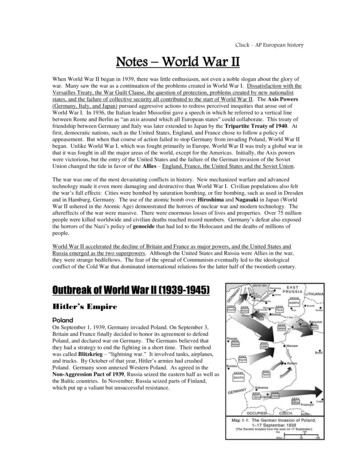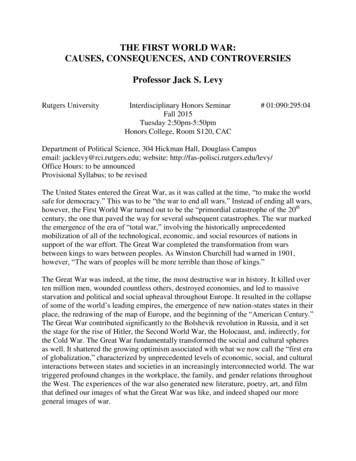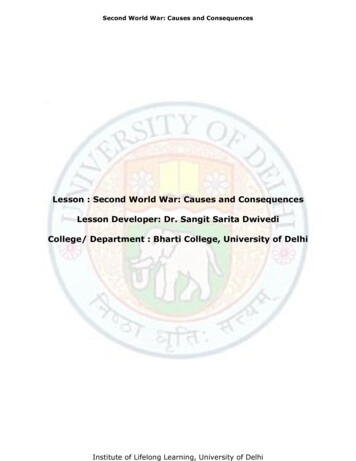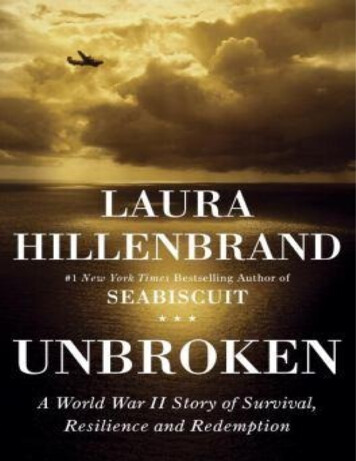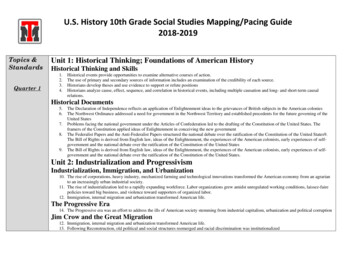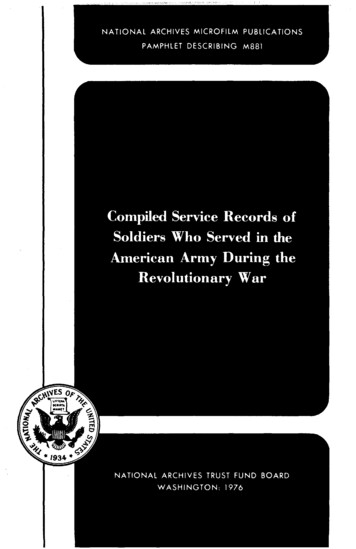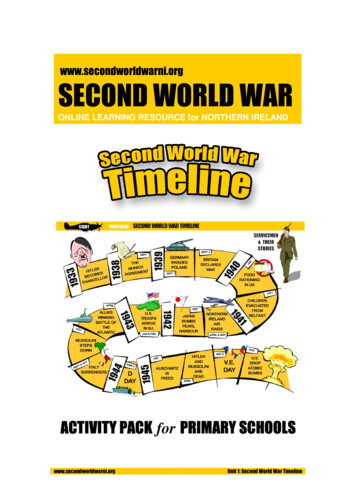
Transcription
www.secondworldwarni.orgSECOND WORLD WARONLINE LEARNING RESOURCE for NORTHERN IRELANDACTIVITY PACK for PRIMARY SCHOOLSwww.secondworldwarni.orgUnit 1: Second World War Timeline
ActivitiesPageAllies, Axis & Neutral Countries3-4Build a Timeline5The Start of the War6Story: Ronnie Cartwright's Capture7Story: Tommy Jess’ Boat Rescue8-9Military Uniforms10-14Sketch A Soldier15Dancing in the Streets16Digital Diary of a nit 1: Second World War Timeline
Map ActivityCountries that fought in the Second World War were divided into two sides: theAllies and the Axis. Countries who were not involved in the war were called NeutralCountries.Allies: Axis Powers:United Kingdom (Great Britain,Scotland & N. Ireland)U.S.A.FranceUSSR (Soviet Union, eceNetherlandsNew ZealandNorwayPolandSouth thuaniaMalta Neutral Countries:GermanyItalyJapan Republic Your TaskColour in the map of Europe to show which European countries were part of theAllies and Axis Powers.1. Select 3 different colours to represent the Allies, the Axis Powers andNeutral Countries. Colour in the Map Key with your chosen colours.2. Using your Map Key colours, colour in the European countries which werepart of the Allies, Axis Powers and Neutral Countries.www.secondworldwarni.orgUnit 1: Second World War Timeline
www.secondworldwarni.orgUnit 1: Second World War Timeline
www.secondworldwarni.orgUnit 1: Second World War TimelineBuild a TimelineFill in the boxes with the important events of each year.Explore the Timeline to learn about the war’s key events.
Read the information for the dates 1933 and 1939, then answer the questions.Why did Great Britain and France declare war on Germany?What were Hitler’s main aims or goals?Examine all of the sources in Sep 3, 1939. People recall of how they first heardthat the second world war had begun.How did people in Northern Ireland first hear the news that Great Britain was at warwith Germany?What types of emotions were people feeling?In Sep 3, 1939, watch the video Video: the beginnings of war. In the video, you willsee pictures of Adolf Hitler and Nazis. People remember hearing that the warwas announced. A soldier remembers seeing German plane for the first time andthe rattle of a machine gun.At the start of the video a woman describes watching a Nazi military parade in Berlinin late 1938 and seeing Hitler. How did the reality of seeing Hitler in person differfrom how people imagined him?At the end of the video a Royal Air Force serviceman talks about capturing a Germansoldier. Why do you think the German soldier was not killed?www.secondworldwarni.orgUnit 1: Second World War Timeline
Daily life for others was behind barbed wire. Ronnie Cartwright, RAF, was shot down onmission number 31 and spent 4 years as a prisoner of war. He recalls vividly the moment hewas shot down and his subsequent capture.I knew that a shell came through the aircraft, behind where I was sitting. An engine was put out oforder, so it must have gone through one of the engines. So we landed four or five miles out in theEnglish Channel. We got into the dinghy, the wee rubber boat we had. Unfortunately that too waspunctured. We had sense enough to hold onto the dinghy even though it was punctured anddeflated. It kept us together so we held onto it.Now it wasn’t until 5 or 6 o’clock in the morning when a German boat came alongside us with aSwastika flying. First of all they threw us out a rope. Before we let go of the old dinghy we all said,“Make sure everybody has got a catch on the rope before you let go.” I remember I felt that I wassinking down into the sea, so I thought, ‘Well, this is it’. I remember opening my mouth just to takea gulp of water but at the same time I must have had my eyes closed.I opened my eyes but I was right at the top of the water almost. I was just underneath the boatand no more. I gave myself another wee pull and I was out. Then the Germans got me onto theboat. I was unconscious. I can’t remember getting onto the boat, but what I do remember iswaking up and seeing a big German standing over me with a great big knife in his hand. He justlooked at me and he said, “For you, the war is over.”Do you think Ronnie was relieved when he saw a boatcoming towards him? Explain your answer.What did the German soldier mean by “For you,the war is over.”?How might Ronnie’s story have ended had he not beencaptured by the Germans?www.secondworldwarni.orgUnit 1: Second World War Timeline
Tommy Jess talks us through the sinking of his ship and his rescue.Royal Navy ABC’sBow – the front end of a shipUpper Deck – the top of the ship whichpeople walk onHatches – the covering of an opening on thedeck of a ship. People would open these toget to the lower decksLife Jacket – a sleeveless jacket to support aperson in deep water to prevent drowningLife Raft – a raft used in emergency whenabandoning shipLower Decks – the floors underneath the topdeckStern – the rear of a shipWhen our ship was hit I was at the bridge at the time cleaning the guns. Well therewas this massive explosion. A bang. It scared the living lights out of me. So I wasblown about ten or twelve feet from the deck. The whole ship shook from stern tobow. There were so many people running around shouting and somebody said,“We’re hit.”I gathered myself up and I ran to my action station. The ship’s doctor, he was goingabout. There was a lot of people lying moaning and he was injecting them and that,you know. Everybody’s running here and running there. The screws of the shipattracts the torpedo and hits the stern of it. The screws that drives the ship. Thesterns blew off with one or two compartments to stay afloat, but we got around a midship’s.I could feel me getting further and further from where I was standing. Further andfurther up. And I said, “My Goodness, the ship’s loosened terrible”, you know. Andthen everybody was trying to get rafts. And most of the lifeboats were shattered anduseless. The next thing I heard was, “Abandon ship, every man for himself.” And Ijumped and I must have jumped as high as this house into the water. I had my lifejacket on. It was one of them ones that you blow up. It wasn’t like the ones you havenow, like. I never got even taken my boots off, I had woollen socks inside them. Youknow and all your heavy clothes, I jumped in with everything.When I came up, I spied this raft you see, and somebody says, “There’s a line.”Somebody was on it already and there was a line attached to the ship from it and Ihad a knife down here in the pocket. I always carried that knife, you see. I cut the lineand the line was about that thick and I had to saw it and saw it until I got it off. It wasabout an inch thick, I’m sure. A couple of boys pulled me onto the raft.www.secondworldwarni.orgUnit 1: Second World War Timeline
Tommy Jess’ Story Continued See you’re in it, you’re in the water in it, but there’s nets - there’s all net – a net bottom.It’s a life raft. There was twelve of us on the raft and they reckon they don’t know wherethey went to. There was only seven of us picked up and the seventh one died after twohours or more. When I jumped the first thing that came into my head is the shock of myfather and mother gets when they hear I’m dead, you know.It was snowing and through the haze I could see the ship. I remember they threw us intoshowers and brought us around and poured brandy down our throats, so I was able tocome around. I spat up oil for days after it, my lungs were full of oil and everything else.You know, you swallowed so much aul oil and stuff. The screams of the men below willhaunt me for the rest of my days, but I could do nothing for them. You see when the shipwas set on all the hatches were jammed and they couldn’t get out, you know so we couldhear them screaming. There was about a hundred and eighty lost.What was it that hitTommy’s ship?Why do you think Tommy hadto cut the line connecting hisship to the life raft?Why did Tommy thinkwas going to happen tohim when he jumped fromhis ship and into thewater?www.secondworldwarni.orgWhat do you think Tommyhad meant when he said,“My goodness, the ship’sloosened terrible.”12 people were on Tommy’slife raft to start but only 7 wererescued. What might havehappened to the others?What happened to themen that were on thelower decks when the shipwas hit?Unit 1: Second World War Timeline
www.secondworldwarni.orgUnit 1: Second World War Timeline
www.secondworldwarni.orgUnit 1: Second World War Timeline
www.secondworldwarni.orgUnit 1: Second World War Timeline
www.secondworldwarni.orgUnit 1: Second World War Timeline
www.secondworldwarni.orgUnit 1: Second World War Timeline
Study the archivephotographs ofsoldiers and officers,their uniforms andrelated artefactsbefore making yourown accurate drawingof a soldier or officer.Your drawing should demonstrate that you have studied archive photographs andartefacts from soldiers and officers from the Second World War.To do this, add some of the following details to your drawing: Add objects, for example a water can or a machine gun Add details to the uniform, for example buttons or medals Place your officer in an appropriate setting, for example on a boat, in the desert Place a flag in the background, for example a Nazi flag or a Union Jack flagFacial ExpressionsWill your officer look happy, sad or scared in your drawing? Think about what yourofficer is doing in the picture and what is happening around him and decide whatemotion he would be feeling at the time. Examine the Facial Expressions below tohelp you with your drawing.www.secondworldwarni.orgUnit 1: Second World War Timeline
Explore MAY 8 and AUGUST 1945 on the timeline before doing this activity.Fill in the blanksVictory in EuropeVictory over JapanAugust 6, 1945surrenderedstreet partieswar songsatomic bombMay 8, 1945bonfiresThe war in Europe officially ended on . This date is knownas VE Day which stands for . On this day theGermans formally to the Allies. People all across NorthernIreland celebrated by having where people danced andsang in the streets of their town. Some people burnedon their main streets.The war in the rest of the world was not yet over. Japan still had not surrendered. Totry and end the war quickly, on America dropped anon the Japanese cities of Nagasaki and Hiroshima.Hundreds of thousands of people were killed and Japan surrendered. This day isknown as VJ Day which stands for . This day marksthe end of the Second World War.www.secondworldwarni.orgUnit 1: Second World War Timeline
Imagine you are a soldier who fought in theSecond World War and lived to tell of theexperience.Since the beginning of the war you kept a diaryin which you wrote down observations of whatwas happening around you at the time as wellas your innermost feelings.Using PowerPoint or similar software, make a‘digital diary’ about your experiences of 5 keyeventsof the war.Writing your five diary entriesSelect 5 dates or key events from your timeline worksheet. These will help form theentries of your diary. Use your timeline worksheet and information you learned fromlistening to people’s accounts to help you write the entries.Think about these questions as you write your entries:What is happening around you? Where are you and what you are seeing?Who are you with? How are you feeling? What are you thinking?Write your diary entries into the spaces provided on the Dear Diary worksheet.Assembling Your Digital Diary in PowerPoint You will need at least one image to illustrate each of your diary entries. Saveimages from the Second World War website to use in your presentation. To dothis, right-click on an image, select Save Image As and save the image into afolder on your computer. If you have drawn a picture of a soldier, you can include it in your presentation,as long as it has been scanned into the computer. Your PowerPoint presentation should have 6 slides: Your title slide, your fivediary entries, and a final slide which says, ‘The End’. Your Title Slide – Diary of John Doe, Age when war began, Name of Hometown.If you have your picture of your soldier, insert in onto this slide. Your five diary entry slides should have the date, the diary entry text, and at leastone picture to illustrate the entry. Use advanced PowerPoint features to format text, use slide transitions, slidetimings or to add borders to pictures.www.secondworldwarni.orgUnit 1: Second World War Timeline
Dear DiaryThis is the Diary of .Hometown DateDateDateDateDatewww.secondworldwarni.orgUnit 1: Second World War Timeline
Adolf HitlerThe German Nazi dictator during World War 2 (1889-1945)AlliesThe countries that fought against the Axis. The main Alliedpowers were Britain and the Commonwealth countries, the US,the Soviet Union, France, China, and PolandAtomic BombAn atomic bomb is an extremely destructive type of bombwhich produces a gigantic cloud shaped like a mushroom. Anatomic bomb can destroy a city.Axis PowersThe three major Axis powers—Germany, Japan, and Italy—were part of a military alliance on the signing of the TripartitePact in September 1940, which officially founded the Axispowers. At their height of power, the Axis powers ruledempires that dominated large parts of Europe, Africa, East andSoutheast Asia and the Pacific Ocean. In World War II theywere defeated which brought an end to the Axis Powers.Benito MussoliniMussolini was the leader of Italy from 1922 to 1943. He alliedItaly with Nazi Germany and Japan in the Second World War.BowThe front end of a shipDinghyA type of small boat, often carried or towed by a larger vesselHatchesThe covering of an opening on the deck of a ship. Peoplewould open these to get to the lower decksHolocaustThe genocide of European Jews and others by the Nazisduring World War 2Life JacketA sleeveless jacket to support a person in deep water toprevent drowningLife RaftA raft used in emergency when abandoning shipLower DecksThe floors underneath the top deckNaziA German member of Adolf Hitler's political partyNeutral CountriesCountries who were not involved in the warwww.secondworldwarni.orgUnit 1: Second World War Timeline
Neville Chamberlain The British Prime Minister of the United Kingdom from May1937 to May 1940. Chamberlain signed of the MunichAgreement in 1938, giving part of Czechoslovakia to NaziGermany. When Adolf Hitler continued his aggression, Britaindeclared war on Germany on 3 September 1939, andChamberlain led Britain through the first eight months of theSecond World War.ServicemanA member of the armed forcesSternThe rear of a shipStreet PartyA party taking place on a road. In Britain, these havehistorically been held to commemorate momentous events,such as VE DaySwastikaA symbol of a cross with its arms bent in right directions. Thissymbol was used on the Nazi flag.Upper Deckthe top of the ship which people walk onVE-Day‘Victory in Europe’ or VE-Day was May 7 and May 8, 1945, thedates when the World War II Allies formally accepted theunconditional surrender of the armed forces of Nazi Germanyand the end of Adolf Hitler's Third Reich.VJ-Day‘Victory over Japan’ Day is a name chosen for the day onwhich Japan surrendered, effectively ending World War 2.Winston ChurchillA British politician known chiefly for his leadership of theUnited Kingdom during World War II. He served as PrimeMinister of the United Kingdom from 1940 to 1945 and againfrom 1951 to 1955.www.secondworldwarni.orgUnit 1: Second World War Timeline
www.secondworldwarni.org Unit 1: Second World War Timeline Fill in the blanks Victory in Europe surrendered atomic bomb Victory over Japan street parties May 8, 1945 August 6, 1945 war songs bonfires The war in Europe officially ended on _ .

